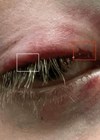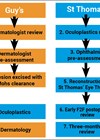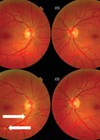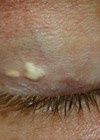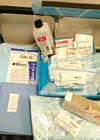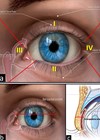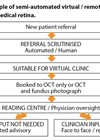Ophthalmology
Hidden eyelid laceration following blunt trauma
A paediatric case report of a hidden eyelid laceration following blunt trauma. Blunt injury to the eyelid can result in a multitude of issues, such as damage to the eyelid margin, lacrimal system and surrounding orbit [1]. These can often...
A novel integrated practice unit (IPU) approach to periocular skin cancer management
The COVID-19 pandemic was one of the biggest challenges to face NHS workers. However, history has repeatedly shown that times of difficulty can result in the development of significant social and technological advances. We describe our own experience of this...
Understanding spaceflight-associated neuro-ocular syndrome (SANS): what do we know?
Introduction Formerly known as visual impairment and intracranial pressure syndrome (VIIP), space-related neuro-ocular syndrome (SANS) is defined by a collection of ophthalmic and neurological findings in astronauts after long-term spaceflight [1]. Changes in the eyeball, such as hyperopic shift, during...
Triamcinolone (TA) deposits following subcutaneous injection to treat chalazion
Chalazia are chronic lipogranulomatous inflammations of the eyelid secondary to a blocked meibomian gland. Whilst most resolve spontaneously, certain chalazia warrant treatment. Options include incision and curettage (I&C), lesion excision, intralesional steroid injections, and botox injections [1]. I&C is usually...
Acute management of retrobulbar haemorrhage
The authors discuss the importance of rapid diagnosis and correct management of acute RBH presentation to avoid the risk of permanent blindness. Retrobulbar haemorrhage (RBH) is an ocular emergency that occurs due to arterial bleeding in the orbital cavity behind...
Periocular burns: a literature review of classification, management protocols and outcomes of treatment
The author provides a review of the current literature regarding the principles of classification, management protocols of acute ocular and periocular burns and the role of the burn and oculoplastic surgeon involved in their care. More than two-thirds of facial...
Post-Brexit deal welcomed but leaves future relationship with EU far from settled
Rod McNeil breaks down the impact of the Brexit deal on healthcare in the UK, including medicines regulation, research funding, sharing of information and the ability to work abroad. A disorderly no-deal exit from the European Union (EU) was averted...
Profile of a tertiary referral oculoplastics service in the UK
The provision of safe and effective ophthalmic care to large patient populations has always been challenging. Severe restrictions of outpatient clinical activity due to the COVID-19 crisis has compounded this problem, with 26,800 appointments cancelled in our unit in the...
Decoding the red eye
Red eye, or hyperaemia, is one of the most common presentations to primary care [1] and the emergency department [2]. However, despite this the underlying cause is often misdiagnosed which can lead to severe, sight-threatening conditions being missed [1]. Thorough...
Eyecare education in times of COVID-19
A collaboration between the German Committee for the Prevention of Blindness (DKVB), Rukwa regional government in Tanzania and the University of St Andrews Global Health Team successfully delivered a hybrid teaching programme for ophthalmic nurses in Sumbawanga, south west Tanzania,...
Telemedicine strategies in ophthalmology: harnessing established and emerging technologies for lasting solutions
The author considers recent progress and shares insights from leading practitioners in telemedicine applications and digital technology strategies. Amidst COVID-19 and combined mitigation and suppression measures, hospitals and clinics have responded rapidly to strengthen telemedicine strategies and virtual healthcare services...
Is patient masking leading to an increase in post-op infection after eyelid surgery?
Due to the COVID-19 pandemic, the use of facemasks or face coverings in the clinical setting has become necessary. It is important to recognise that facemasks can be a source of infection after eye surgery and consider ways to minimise...


